PSYC 105 - CH 3-4: Perception
5.0(1)
5.0(1)
Card Sorting
1/50
Earn XP
Description and Tags
Study Analytics
Name | Mastery | Learn | Test | Matching | Spaced |
|---|
No study sessions yet.
51 Terms
1
New cards
Akinetopsia
* unable to perceive motion
* cannot tell if movement is occurring
* cannot see the “in between” when objects are in motion
* cannot tell if movement is occurring
* cannot see the “in between” when objects are in motion
2
New cards
Rods
* sensitive in low light
* lower acuity
* color-blind
* periphery of the retina
* lower acuity
* color-blind
* periphery of the retina
3
New cards
Cones
* Need more light
* higher acuity
* color-sensitive
* in the fovea
* higher acuity
* color-sensitive
* in the fovea
4
New cards
Visual system
light to perception
* In the eye:
* photoreceptors
* bipolar cells
* ganglion cells and the optic nerve
* int he thalamus:
* Lateral geniculate nucleus (LGN)
* In the cortex:
* V1: the primary visual projection area, or primary visual cortex, located in the *occipital lobe*
* if damaged = “blind”, no sight
* In the eye:
* photoreceptors
* bipolar cells
* ganglion cells and the optic nerve
* int he thalamus:
* Lateral geniculate nucleus (LGN)
* In the cortex:
* V1: the primary visual projection area, or primary visual cortex, located in the *occipital lobe*
* if damaged = “blind”, no sight
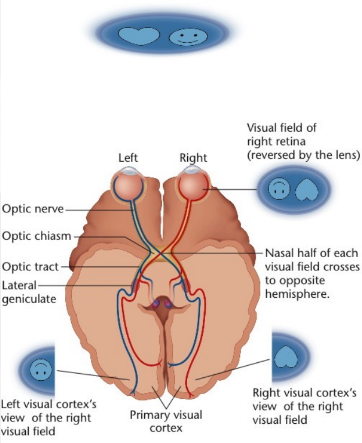
5
New cards
Lateral inhibition
a neuron’s response to a stimulus is inhibited by the excitation of a neighboring neuron
* occurs in cells in the retina
* each active cell inhibits its neighbors
* **Emphasizes the “edge” of the stimulus → “creates a contrast in stimulation that allows increased sensory perception”**
* occurs in cells in the retina
* each active cell inhibits its neighbors
* **Emphasizes the “edge” of the stimulus → “creates a contrast in stimulation that allows increased sensory perception”**
6
New cards
Receptive field
the size and shape of the area in the visual world to which that cell responds
* on-center/off surround cell
* stimulus in center leads to fast firing rates
* stimulus in surrounding are leads to slower firing rates (relative to baseline)
* on-center/off surround cell
* stimulus in center leads to fast firing rates
* stimulus in surrounding are leads to slower firing rates (relative to baseline)
7
New cards
Edge detectors
each cell will respond to a vertical, or horizontal light respectively
* the receptive fields of some visual neurons are lines of particular orientations
* the receptive fields of some visual neurons are lines of particular orientations
8
New cards
binding problem
parallel processing splits up processing of our world → but we do not see the worlds as disjointed
9
New cards
spatial position
helps solve the binding problem
* reassembling of pieces references position
* reassembling of pieces references position
10
New cards
neural synchrony
helps solve the binding problem
* the rhythms of neurons that are firing in response to the same item (some for color, some for motion, etc.) tend to be in sync
* the rhythms of neurons that are firing in response to the same item (some for color, some for motion, etc.) tend to be in sync
11
New cards
Attention binding
critical for the binding of visual features
* when ________ is overloaded, people will make conjunction errors
* ex: seeing a blue “H” and a red “T” but reporting a red “H”
* when ________ is overloaded, people will make conjunction errors
* ex: seeing a blue “H” and a red “T” but reporting a red “H”
12
New cards
sensation
absorbing raw energy (e.g., light waves, sound waves) through our sensory organs
* for the most part, everyone has the same ___ to the same stimulus
* for the most part, everyone has the same ___ to the same stimulus
13
New cards
Transduction
conversion of this energy to neural signals
14
New cards
Attention
concentration of mental energy to process incoming information
15
New cards
perception
selecting, organizing, and interpreting these signals
* the process of recognizing, organizing, and interpreting information from senses
* Not an exact copy of “the world”
* based on our past experience and expectations
* the process of recognizing, organizing, and interpreting information from senses
* Not an exact copy of “the world”
* based on our past experience and expectations
16
New cards
Bottom-up processing
when the environment (stimuli) influences our thinking
* perception may start with the **senses**
* incoming raw data
* energy registering on receptors
* perception may start with the **senses**
* incoming raw data
* energy registering on receptors
17
New cards
Top-down processing
when our thinking influences how we see (understand/perceive) the environment
* making inferences based on context, guessing from experience, and basing one perception on another
* perception may start with the **brain**
* person’s knowledge, experience, and expectations shape perception
* occurs quickly, automatically
* making inferences based on context, guessing from experience, and basing one perception on another
* perception may start with the **brain**
* person’s knowledge, experience, and expectations shape perception
* occurs quickly, automatically
18
New cards
Recognition-by-components (RBC)
bottom-up processing
* we perceive objects by perceiving elementary features
* Geons: three-dimensional volumes
* objects are recognized when enough information is available to identify object’s geons
* we perceive objects by perceiving elementary features
* Geons: three-dimensional volumes
* objects are recognized when enough information is available to identify object’s geons
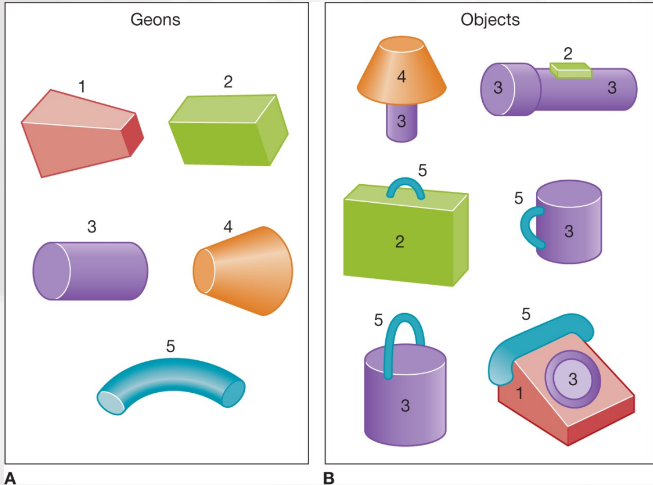
19
New cards
geons
* discriminability: ____ can be distinguished from other geons from almost all viewpoints
* Resistance to visual noise: ______ can be perceived in “noisy” conditions
* distinctiveness: 36 different _______ have been identified
* Resistance to visual noise: ______ can be perceived in “noisy” conditions
* distinctiveness: 36 different _______ have been identified
20
New cards
Helmholtz’s Theory
theory of unconscious inference
* we infer much of what we know about the world
* likelihood principle: we perceive the world in the way that is “most likely” based on our past experiences
* we infer much of what we know about the world
* likelihood principle: we perceive the world in the way that is “most likely” based on our past experiences
21
New cards
Perceiving size
bottom-up processing
* the size of the image on the retina
Top-down processing
* the perceived distance of the object
* the size of the object relative to other objects in the environment
* the size of the image on the retina
Top-down processing
* the perceived distance of the object
* the size of the object relative to other objects in the environment
22
New cards
Depth perception
the ability to see things in three dimensions (including length, width and depth), and to judge how far away an object is
* occurs even when looking at 2D images
* is present, at least in part, at birth in humans and other animals
* occurs even when looking at 2D images
* is present, at least in part, at birth in humans and other animals
23
New cards
Binocular cues
depth cues that require the use of two eyes
24
New cards
Retinal disparity
used to perceive depth between two near objects by comparing the different images from both retinas
* is a bottom-up cue of depth → it is not based on knowledge about the world
* is a bottom-up cue of depth → it is not based on knowledge about the world
25
New cards
Monocular cues
depth cues available to either eye alone
* are top-down cues of depth → they are based on the knowledge you have about the world
Includes
* relative size
* interposition
* relative motion
* light and shadow
* linear perspective
* are top-down cues of depth → they are based on the knowledge you have about the world
Includes
* relative size
* interposition
* relative motion
* light and shadow
* linear perspective
26
New cards
Constancy
things look different depending in the angle, distances, and lighting but our perception is constant
Perceptual _____
* Size
* Shape
* Brightness
* Color
Perceptual _____
* Size
* Shape
* Brightness
* Color
27
New cards
Size constancy
we perceive the size of an object as constant from different distances
* however, context matters (ex: moon illusion)
* however, context matters (ex: moon illusion)
28
New cards
Shape constancy
even though the shape of the door on our retinal image differs, we see the true shape of the door as unchanging
29
New cards
Gestalt Laws of Perceptual Organization
reflect experience, are used unconsciously, but may be occasionally misleading
* similarity
* proximity
* good continuation
* closure
* simplicity
* similarity
* proximity
* good continuation
* closure
* simplicity
30
New cards
Form perception
the process through which the basic shape and size of an object are seen
* figure-ground: organization of visual field into objects that stand out from their surroundings
* grouping: the perceptual tendency to organize stimuli into meaningful groups (gestalt principle)
* utilizes both bottom-up and top-down perception processes
* figure-ground: organization of visual field into objects that stand out from their surroundings
* grouping: the perceptual tendency to organize stimuli into meaningful groups (gestalt principle)
* utilizes both bottom-up and top-down perception processes
31
New cards
good continuation
law of continuity
* we tend to see shapes/lines as being continuous even when occluded
* we tend to see shapes/lines as being continuous even when occluded
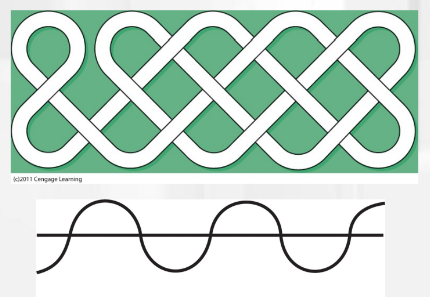
32
New cards
simplicity
law of good figure
* every stimulus pattern is seen so the resulting structure is as simple as possible
* every stimulus pattern is seen so the resulting structure is as simple as possible
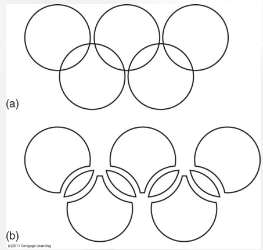
33
New cards
similarity
similar things appear grouped together
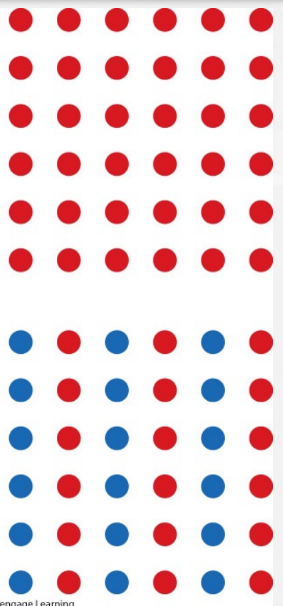
34
New cards
proximity
things near each other appear grouped together
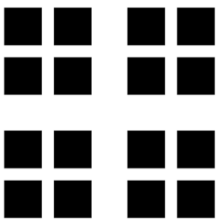
35
New cards
closure
we tend to perceive closed figures rather than incomplete ones

36
New cards
object recognition
process through which the object is identified
* utilizes both bottom-up and top-down perception processes
* recognition through **features**: small elements that result from the organized perception of form
* ie: visual search task
* utilizes both bottom-up and top-down perception processes
* recognition through **features**: small elements that result from the organized perception of form
* ie: visual search task
37
New cards
Serial search
search every stimulus one by one for target
* RT depends on display size
* RT depends on display size
38
New cards
Parallel search
target stimulus “pops out” from the rest
* RT does not depend on display size (or is dependent to a much lesser degree)
* RT does not depend on display size (or is dependent to a much lesser degree)
39
New cards
feature-based recognition
damage to the parietal cortex results in difficulty in judging how more than one feature is bound together in objects
* integrative agnosia
* disruption of parietal cortex via TMS
* subject can do a feature search but not a conjunctive search
* integrative agnosia
* disruption of parietal cortex via TMS
* subject can do a feature search but not a conjunctive search
40
New cards
Word frequency effect
high frequency words recognized better
41
New cards
Repetition priming effect
recently viewed words recognized better
42
New cards
Word superiority effect
letters recognized better in the context of a word
* response when asked whether “DARK” has an “E” or a “K” is more accurate than when “E” or “K” is presented alone
* effect does not occur if a letter string such as “JPERW” is used instead of a real word
* response when asked whether “DARK” has an “E” or a “K” is more accurate than when “E” or “K” is presented alone
* effect does not occur if a letter string such as “JPERW” is used instead of a real word
43
New cards
Feature nets
propose that recognition depends on a network of “detectors”, organized in layers of increasing granularity
* "Neural networks”
* have receptive fields
* fire above threshold
* detectors do not represent actual individual neurons
* recent firing = higher starting activation level
* explains word frequency effect and repetition priming
* "Neural networks”
* have receptive fields
* fire above threshold
* detectors do not represent actual individual neurons
* recent firing = higher starting activation level
* explains word frequency effect and repetition priming

44
New cards
bigrams
a pair of consecutive written units such as letters, syllables, or words
* can be part of the neural network
* helps explain the word-superiority effect
* can be part of the neural network
* helps explain the word-superiority effect

45
New cards
Ventral stream
the **what** pathway
* refers to the visual paths in the temporal cortex
* specialized for identifying and recognizing objects
* refers to the visual paths in the temporal cortex
* specialized for identifying and recognizing objects
46
New cards
Dorsal stream
the **where** pathway
* refers to the visual path in the parietal cortex
* helps the motor system to find objects and move towards them
* refers to the visual path in the parietal cortex
* helps the motor system to find objects and move towards them
47
New cards
Single dissociation
one function is lost, another remains
* ie: one stream is damaged but not the other
* shows that the what and where rely on different mechanisms, although they may not operate totally independent of one another
* ie: one stream is damaged but not the other
* shows that the what and where rely on different mechanisms, although they may not operate totally independent of one another
48
New cards
Double dissociation
requires two individuals with different damage and opposite deficits
* indicates that the what and where streams must have different mechanisms and operate independently of one another
* indicates that the what and where streams must have different mechanisms and operate independently of one another
49
New cards
Visual agnosia
the inability to recognize objects despite satisfactory vision
* there are many types of visual agnosia, caused by damage to various visual areas (occipital, temporal, or parietal)
* can identify people and faces
* their knowledge is accessible to other pathways (ie: touch), but not their visual pathway
* there are many types of visual agnosia, caused by damage to various visual areas (occipital, temporal, or parietal)
* can identify people and faces
* their knowledge is accessible to other pathways (ie: touch), but not their visual pathway
50
New cards
Prosopagnosia
is a type of agnosia also know as face blindness
* occurs after damage to the fusiform gyrus of the inferior temporal cortex
* can see the textures and features of a face but cannot put them together to recognize or identity the face
* occurs after damage to the fusiform gyrus of the inferior temporal cortex
* can see the textures and features of a face but cannot put them together to recognize or identity the face
51
New cards
Holistic processing
we process faces as a whole
* harder to process just the top or just the bottom when the faces are aligned
* harder to process just the top or just the bottom when the faces are aligned